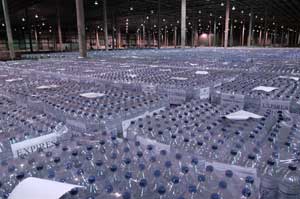“Every minute of every day, 22 people die because they cannot get enough safe water,” according to Frederik Segerfeldt, author of Water for Sale. Everybody wants clean, safe water that tastes good. Bottled water is a convenient, calorie-free source of liquid. What’s not to love? Take a stab at guessing whether the following bits of information are true or false.
 |
Bottled water comes in handy in hot or dry climates, during outdoor activities, and in emergency situations. However, there are a number of health and environmental issues associated with this convenience. Wikimedia Commons photo |
1. Bottled water was first sold in the U.S. in 1990.
2. Bottled water comes from pristine mountain streams.
3. Bottled water tastes better.
4. Bottled water is safer than tap water from public drinking water supplies.
5. Bottled water is a bargain.
6. Most plastic bottles are recycled after use.
ANSWERS
Although you may have heard many of the above claims in marketing campaigns, every single one falls in the Poppycock Category.
1. Perrier carbonated mineral water has been bottled in France since the late 1800s, where it sold for three times the price of wine. It was first marketed as a luxury item in the U.S. in 1976. Evian mineral water entered the U.S. market in 1978. Today, 74% of Americans drink bottled water. In 2005, consumers spent $100 billion worldwide on bottled water (sources: Corporate Accountability International [CAI], Perrier and Evian websites). Sales of bottled water have continued to climb over the years, with double digit growth from 2002-2005. U.S. bottled water sales slipped 0.4% in 2008, perhaps in response to economy and environmental backlash (source: Wall Street Journal).
2. Up to 25-40% of bottled water comes from a tap, despite alluring pictures of pristine, snow-capped mountains on the labels (Sources: NRDC, CAI). On the other hand, large volumes of water bottled from natural springs can impact nearby streams, wells, farms and ecosystems.
3. When Good Morning America conducted a blind taste test with its studio audience, New York City tap water was chosen as the heavy favorite over the oxygenated waters Poland Spring, 02 and Evian. Some bottled water tastes worse than tap water when it picks up the plastic taste from the bottle or jug. Water sold in plastic bottles can contain plasticizers like DEHP and BPA, both of which are endocrine-disrupting chemicals that children should not consume (source: Consumer Reports).
If you thought this was a fact, you are not alone. Marketing campaigns have convinced one in five Americans that the only place to get clean water is from a bottle (source: CAI, 2009). Bottled water quality is not well regulated. The FDA only requires bottled water companies to test their water once a month, they do not have to use certified laboratories, and they do not have to report their results to the FDA, even if contaminants exceed safety standards. There are no standards for some contaminants like BPA. On the other hand, EPA requires municipal water companies to test their water quality several times a day, and to make results available to consumers (see http://www.epa.gov/safewater/dwinfo/index.html) Eroding confidence in public water supplies has many consequences, such as decreasing taxpayer willingness to fund necessary water system maintenance and upgrades.
Bottled water costs more per ounce than gasoline. If your self-esteem depends on status symbols, try Bling H20’s Dubai Collection of bottled water, which comes adorned 10,000 hand-applied Swarovski Crystals, for a mere $2,600.
6. Despite the fact that an estimated 80% of Americans have access to a plastics recycling program (Earth991.com), about 77% of plastic bottles are wasted. On a global basis, about 86% of plastic containers end up as garbage or litter (sources: U.S. EPA, Container Recycling Institute.) The plastics industry has lobbied hard to prevent required recycling of plastic bottles. Unfortunately, plastic will last for centuries, if not more, in a landfill. To add insult to injury, manufacturing a years worth of plastic bottles consumes about 15 billion barrels of oil (source: Philadelphia Inquirer, 2007). That figure does not count resources consumed in transportation
See next week’s articles for alternatives to bottled water.

